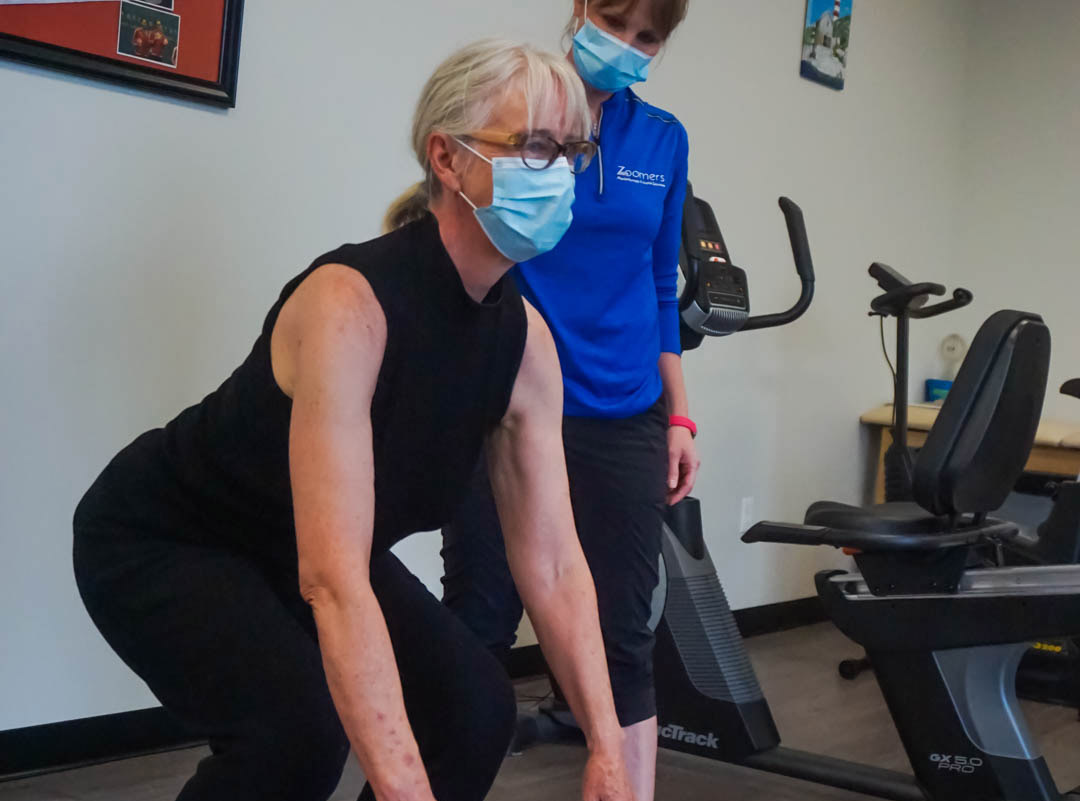Book an assessment with Zoomers now!
Use our online booking tool to find a time that works for you!
As a physiotherapist, my clients would be the first to tell you that I’m not afraid of asking them to work through pain if it’s helpful. The question is, when is it helpful? When healing from an injury, we often expect discomfort during the recovery process. However, what about during a regular exercise routine?
Every year I see seniors in my physiotherapy practice in Halifax who accidentally injured themselves during physical activities or exercise. Often times, in hindsight, they can see the warning signals that their bodies were giving them prior to the injury. However, while doing the activities or exercises, they interpreted these symptoms to be a sign of hard work, not of impending injury.
The phrase, “No Pain, No Gain” was popularized in the 1980s by Jane Fonda as she led high-intensity exercise workouts. Participants were encouraged to “feel the burn” to know they were doing the exercises correctly and with the right amount of effort. Fonda’s references were related to the normal mild discomfort and perceived “heat” in a muscle that is felt when exercising at a high intensity. This discomfort is generally safe for adults (including seniors) as long as it is short-lived and the muscle recovers completely between workouts. It is also normal (and safe) to feel mild tightness in the muscles for 1-2 days after exercise. This tightness is typically relieved with light aerobic activity (a walk or bike ride) or gentle stretching. For seniors, the recovery time required between strenuous activities can sometimes be longer.
There is a phenomenon called Delayed Onset Muscle Soreness (DOMS) that is worth mentioning. High-intensity exercise can result in severe muscle discomfort that begins 12-24 hours after exercise and peaks between 48-72 hours afterwards. Although the muscle will recover from DOMS spontaneously, it must not occur after every workout. If the muscle comfort isn’t restored before the next session, additional exercise can contribute to muscle breakdown instead of muscle building. This is particularly problematic for seniors whose muscles may take slightly longer to recover from strenuous activities.
It is also important for seniors to monitor how their joints are feeling. The damp weather in Halifax often contributes to increased pain in joints for local seniors. However, joints should not typically be made more painful during or after exercise. If there is pain in joints (such as the knees) during physical activities, it is often associated with a technique problem. The technique of any activities that are painful should be assessed by a professional and, if needed, corrected before continuing with the program. Mild joint pain during exercise (that isn’t associated with the weather in Halifax!) can escalate over time creating larger problems; early intervention is key in injury prevention.
Pain, swelling or stiffness in a joint that develop following exercise is a significant warning sign. If Halifax seniors start to experience these symptoms after physical activities, they should discuss their symptoms with a physiotherapist. With professional guidance, seniors can determine which activities and exercises suit their joints best and how quickly it is safe to return to them.
The exception to the rule of joint pain during exercise is if seniors have an underlying condition like osteoarthritis. In this case, it is expected that the joint may be painful during physical activities. However, if they have had professional guidance regarding the type, technique and volume of activities, a minimal amount of joint pain may be acceptable and safe for Halifax seniors during their exercise program.
Ultimately, exercise should help Halifax seniors feel better, not worse. Mild discomfort may be acceptable during exercise but it is important to be monitoring both the muscles and joints for signs that the routine of physical activities needs to be adjusted.
At Zoomers in Halifax, our physiotherapists regularly assess seniors’ movement patterns and exercise programs to ensure they are setting themselves up for success and not injury. As they say… an ounce of prevention is worth a pound of cure!
Book an assessment with Zoomers
Use our online booking tool to find a time that works for you!


